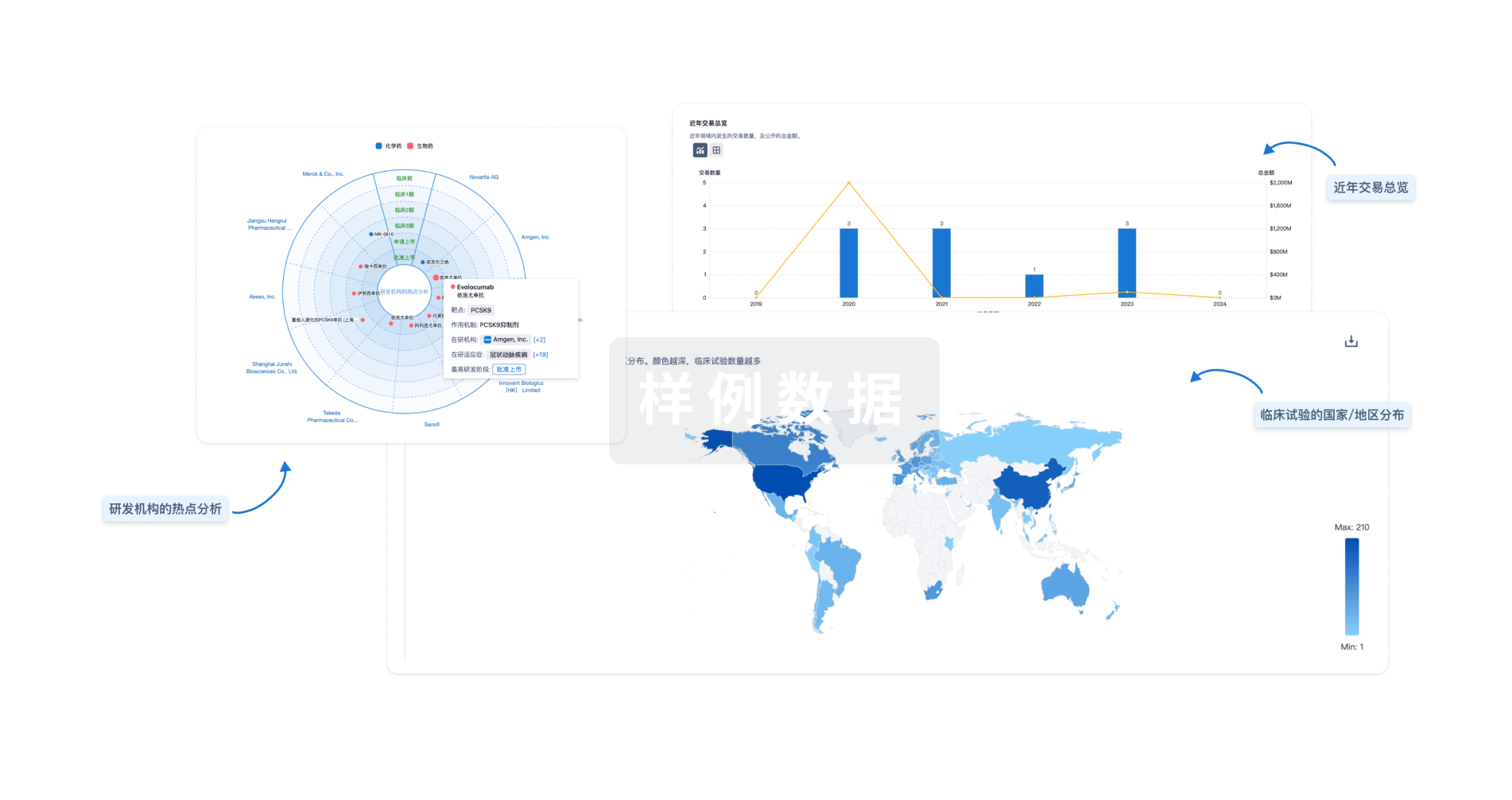预约演示
更新于:2025-05-07
sucrase
更新于:2025-05-07
基本信息
别名 alpha-glucosidase、Alpha-methylglucosidase、Isomaltase + [7] |
简介 Plays an important role in the final stage of carbohydrate digestion. Isomaltase activity is specific for both alpha-1,4- and alpha-1,6-oligosaccharides. |
关联
3
项与 sucrase 相关的药物靶点 |
作用机制 sucrase刺激剂 |
在研机构 |
在研适应症 |
非在研适应症- |
最高研发阶段批准上市 |
首次获批国家/地区 美国 |
首次获批日期1998-04-09 |
靶点 |
作用机制 sucrase刺激剂 |
在研机构 |
原研机构 |
在研适应症 |
非在研适应症- |
最高研发阶段药物发现 |
首次获批国家/地区- |
首次获批日期1800-01-20 |
靶点 |
作用机制 sucrase刺激剂 |
原研机构 |
在研适应症 |
非在研适应症- |
最高研发阶段药物发现 |
首次获批国家/地区- |
首次获批日期1800-01-20 |
3
项与 sucrase 相关的临床试验NCT05703009
A Double-Blind, Placebo-Controlled, Crossover Study of Sacrosidase for the Treatment of Subjects With Fructan Intolerance
SSDXA-14 is a Phase 2 (feasibility/pilot) double-blind, placebo-controlled, crossover study to evaluate the efficacy and safety of sacrosidase and placebo in 25 subjects objectively diagnosed with fructan intolerance.
开始日期2023-06-05 |
申办/合作机构 |
NCT05480761
Evaluation of a 7-Day Therapeutic Trial Dose of Commercial Sucraid® (Sacrosidase) Oral Solution for Alleviating Congenital Sucrase-Isomaltase Deficiency (CSID) Symptoms in Pediatric Subjects With Low, Moderate, and Normal Sucrase Levels
This is a Phase 4, U.S. only, multi-center study using a 7-day therapeutic response dose (TRD) of commercial Sucraid® to assess the response of treatment in 1100 symptomatic pediatric (6 months to 17 years old) subjects with low, moderate, and normal sucrase activity determined by a disaccharidase assay via EGD within 1 year of the Screening Visit. This study will also explore the relationship between known genetic CSID mutations and sucrase activities via (EGD) disaccharidase assay (low, moderate, and normal).
开始日期2022-08-01 |
申办/合作机构 |
NCT02784067
A Multicenter, Double-Blind, Placebo-Controlled Trial to Evaluate the Frequency of Genetic Sucrase-Isomaltase Deficiency Genotypes, and the Efficacy and Safety of Sucraid® (Sacrosidase) Oral Solution in Subjects With Chronic Diarrhea and Sucrase Deficiency
S09A is a Phase 4, multicenter, randomized, double-blind, placebo-controlled, parallel study examining the efficacy and safety of a Sucraid (sacrosidase) Oral Solution in comparison to a placebo in 150-200 subjects with chronic diarrhea possibly attributable to sucrase deficiency.
开始日期2016-05-01 |
申办/合作机构 |
100 项与 sucrase 相关的临床结果
登录后查看更多信息
100 项与 sucrase 相关的转化医学
登录后查看更多信息
0 项与 sucrase 相关的专利(医药)
登录后查看更多信息
3,821
项与 sucrase 相关的文献(医药)2025-08-01·Environmental Research
Microplastics alter microbial structure and assembly processes in different soil types: Driving effects of environmental factors
Article
作者: Wang, Xiaoxing ; Li, Zhaojun ; Andom, Okbagaber ; Zhang, Jiaqi ; Guo, Xueqi ; Li, Yanli ; Li, Qingjie
2025-07-01·Food Chemistry
Tentative characterization of three novel coumaroyl glucoside β-carboline alkaloids and discovery of hypoglycemic compounds from Nitraria tangutorum Bobr. Fruit
Article
作者: Li, Jiaxin ; Wu, Li ; Li, Zhen ; Jiang, Sirong ; Yue, Huilan ; Wang, Fei ; Zhao, Xiaohui
2025-06-01·Journal of Hazardous Materials
Bioavailability, migration and driving factors of As, Cd and Pb in calcareous soil amended with organic fertilizer and manganese oxidizing bacteria in arid northwest China
Article
作者: He, Liang ; Long, Song ; Wang, Shengli ; Ning, Xiang
110
项与 sucrase 相关的新闻(医药)2025-04-05
·今日头条
【导读】
脂肪酸合酶(FASN)是脂质代谢中的关键酶,在这些过程中发挥着重要作用。然而,FASN 介导的脂质重编程与结直肠癌(CRC)中免疫反应之间的关系仍不清楚。
3月28日,苏州大学研究团队在期刊《Cell Death Discovery》上发表了研究论文,题为“FASN promotes lipid metabolism and progression in colorectal cancer via the SP1/PLA2G4B axis”,本研究证实,脂肪酸合成酶(FASN)在结直肠癌(CRC)组织中的表达升高,并且与不良预后显著相关。功能实验表明,FASN 可促进 CRC 细胞的增殖、迁移、侵袭以及PC的生成。此外,体内实验显示,FASN 敲低可显著抑制肿瘤生长以及 CRC 细胞向肺部的转移。机制上,CRC 组织中上调的 FASN 通过 SP1/PLA2G4B 轴驱动癌细胞增殖、转移以及 PC 代谢,进而以 PC 依赖的方式抑制自然杀伤(NK)细胞的抗肿瘤反应。
这些发现为 CRC 的脂质代谢和免疫生物学提供了新的见解,为 CRC 的治疗和预防提供了潜在靶点。
https://www.nature.com/articles/s41420-025-02409-9#Sec11
研究背景
01
结直肠癌(CRC)是全球第三大常见恶性肿瘤,也是癌症相关死亡的第二大原因。CRC 的发病机制复杂,涉及多种因素,如基因突变、肠道微生物失调和代谢紊乱。肿瘤的快速生长常常导致营养匮乏的肿瘤微环境(TME),迫使癌细胞进行代谢重编程以适应这些能量限制。越来越多的证据表明,这种异常的代谢重编程对于 CRC 的发生、生长和转移至关重要。
脂质代谢是癌细胞的一个关键代谢特征,与癌症的发生、发展和耐药性密切相关。许多研究表明,脂质的动态变化,会影响包括结直肠癌(CRC)在内的多种癌症的发生和发展。脂质代谢酶的失调会导致癌症中的脂质代谢重编程。FASN 是脂质代谢中的关键酶,催化脂肪酸的从头合成,支持细胞生长和存活。FASN 在脂质代谢重编程中的致癌作用已在多种肿瘤中得到充分证实。由 ACAT1 介导的 GNPAT 乙酰化稳定 FASN,促进脂质代谢重编程和肝癌的发生。然而,关于 FASN 在 CRC 脂质代谢重编程中的机制仍知之甚少。
FASN促进结直肠癌(CRC)细胞的增殖、迁移和侵袭以及PC的合成
02
为了更深入地了解FASN在结直肠癌(CRC)中的生物学作用,研究人员抑制了 RKO 和 HCT-116 细胞中的 FASN 表达。三种靶向FASN 的小干扰 RNA(siRNA)(si-FASN-001、si-FASN -002 和 si-FASN-003)显著降低了 HCT-116 和 RKO 细胞中 FASN 的 mRNA 水平和蛋白表达。由于 si-FASN-001 对 CRC 细胞中 FASN 表达的抑制作用最强,因此使用 si-FASN-001 的序列生成了 FASN shRNA(sh-FASN)慢病毒,并构建了稳定敲低 FASN 的 HCT-116 和 RKO 细胞。研究人员观察到 si-FASN-001、si-FASN -002 和 sh-FASN 显著降低了 HCT-116 和 RKO 细胞的增殖。迁移实验证实,FASN 下调抑制了 RKO 和 HCT-116 细胞的迁移和侵袭能力。鉴于PC是脂滴的重要定量成分,研究人员使用油红 O 染色来检测和可视化细胞中的脂滴含量。FASN 敲低显著降低了 HCT-116 和 RKO 细胞中的脂滴含量。此外,ELISA显示,在敲低脂肪酸合酶(FASN)后,HCT-116 和 RKO 细胞的细胞上清液中 PC 水平降低。
FASN敲低抑制结直肠癌细胞的增殖、迁移和侵袭以及PC的合成
研究结论
03
总之,本研究证明了在结直肠癌患者的癌组织中增加的FASN通过 SP1/PLA2G4B 轴促进癌细胞增殖、转移和PC代谢,进而以 PC 依赖的方式抑制自然杀伤(NK)细胞的抗肿瘤反应。本研究结果不仅为结直肠癌的脂质代谢和免疫生物学提供了新的见解,还为结直肠癌的治疗和预防指出了有前景的靶点。
参考资料:
https://www.nature.com/articles/s41420-025-02409-9#Sec11
【关于投稿】
转化医学网(360zhyx.com)是转化医学核心门户,旨在推动基础研究、临床诊疗和产业的发展,核心内容涵盖组学、检验、免疫、肿瘤、心血管、糖尿病等。如您有最新的研究内容发表,欢迎联系我们进行免费报道(公众号菜单栏-在线客服联系),我们的理念:内容创造价值,转化铸就未来!
转化医学网(360zhyx.com)发布的文章旨在介绍前沿医学研究进展,不能作为治疗方案使用;如需获得健康指导,请至正规医院就诊。
责任声明:本稿件如有错误之处,敬请联系转化医学网客服进行修改事宜!
微信号:zhuanhuayixue
热门推荐活动 点击免费报名
🕓 线上|2025年4月2日19:00-21:00
▶ 大咖领衔,共话携筛 | 基因科技开拓携带者筛查新纪元
🕓 上海|2025年6月12-15日
▶ 第七届上海国际癌症大会暨中国生物工程学会医学生物技术专业委员会年会暨第六届中德双边论坛
🕓 北京|2025年09月19-20日
▶ 第六届单细胞技术应用研讨会暨空间组学前沿研讨会
点击对应文字 查看详情
siRNA临床研究
2025-03-14
·医药速览
EGFR是人表皮生长因子受体ErbB家族的一员,具有酪氨酸激酶活性,研究表明EGFR参与人类不同类型癌症发病和进展。HER3是ErbB家族的一种独特的假激酶受体,研究表明其会介导对EGFR靶向治疗的抗性。
BL-B01D1由一种针对EGFR/HER3的双特异性抗体SI-B001、一种组织蛋白酶B可切割连接子GGFG和一种新型拓扑异构酶I抑制剂Ed-04组成,后者是喜树碱衍生物,在第一三共的Dxd的α亚酰氨处进行了改进,可驱动细胞周期阻滞在S期和随后的凋亡,BL-B01D1具有高药抗比DAR=8,且linker高度稳定。
SI-B001是百利天恒美国子公司Systimmune基于其专有SEBA平台开发的靶向EGFR和HER3的双抗,可同时结合EGFR/EGFR同源二聚体和EGFR/HER3异源二聚体,阻断下游信号通路,实现抑制和杀伤肿瘤的目的。
从结构示意图可以看出,针对EGFR一端具有高亲和力,针对HER3一端具有弱亲和力,这样的设计可以使药物具有优先结合倾向,避免过度靶向HER3引发毒性,专利数据显示抗体靶向EGFR端来源于西妥昔单抗,亲和力为4.61nM, HER3抗体来源于MM-111,亲和力为117nM。
抗体与EGFR的亲和力
抗体与HER3的亲和力
抗体序列如下:
此外抗体部分保留了Fc介导的免疫活性:
百利天恒官网显示BL-B01D1开展的临床研究进展如下:
2024年中山大学张力、赵洪云教授团队在国际顶级杂志《柳叶刀肿瘤》发表了BL-B01D1治疗晚期实体瘤的I期临床研究结果。
这是一项开放标签、多中心、剂量递增和剂量扩展的1期临床试验,共纳入195名患者,其中113名为非小细胞肺癌,42名为鼻咽癌,其余为小细胞肺癌、头颈部鳞状细胞癌等。
研究方法
Phase 1a阶段采用i3+3设计,患者接受不同剂量和给药方案的BL-B01D1治疗,主要目标是确定MTD和DLT;Phase 1b阶段在确定的剂量下进一步评估安全性,并确定推荐的2期剂量RP2D, ORR是关键次要终点;纳入18-75岁的患者(剂量递增阶段)或18岁以上的患者(剂量扩展阶段),预期寿命至少3个月,ECOG表现状态为0-1,且有组织学或细胞学确认的局部晚期或转移性实体瘤。
研究结果
在剂量递增阶段,观察到4例剂量限制性毒性(均为发热性中性粒细胞减少症),MTD确定为3.0 mg/kg每周一次和6.0 mg/kg每3周一次。根据研究结果,研究团队推荐每3周为周期在第1天和第8天注射2.5 mg/kg的剂量作为中国患者的2期推荐剂量(R2PD)。
71%的患者出现3级或更严重的治疗相关不良事件(TRAEs),最常见的是中性粒细胞减少症(47%)、贫血(39%)、白细胞减少症(39%)和血小板减少症(32%)。3%的患者因TRAEs停药,27%的患者需要减量。
在174名可评估的患者中,中位随访时间为6.9个月,34%的患者达到客观反应(ORR),中位反应持续时间为8.5个月,中位无进展生存期(PFS)为5.7个月,疾病控制率(DCR)为89%。
值得注意的是,在EGFR突变阳性NSCLC中,ORR达到52.5%,显示出较高的活性,而目前标准治疗的客观缓解率为26.7%-48.1%不等。在EGFR野生型NSCLC中,ORR为31%,也表现出一定的抗肿瘤效果,目前针对这类人群标准治疗药物有效率仅为16.6%。在鼻咽癌中,ORR为38%,提示其在这一特定适应症中也有潜在的治疗价值。
未观察到EGFR或HER3表达与抗肿瘤反应之间的关系
往期精选
点击获取
参考资料
WO_2022061255_A1
DOI: 10.1016/S1470-2045(24)00159-1
官网资料
网络媒体资料往期链接
“小小疫苗”养成记 | 医药公司管线盘点
人人学懂免疫学| 人人学懂免疫学(语音版)
综述文章解读 | 文献略读 | 医学科普|医药前沿笔记
PROTAC技术| 抗体药物| 抗体药物偶联-ADC
核酸疫苗 | CAR技术| 化学生物学
温馨提示
医药速览公众号目前已经有近12个交流群(好学,有趣且奔波于医药圈人才聚集于此)。进群加作者微信(yiyaoxueshu666)或者扫描公众号二维码添加作者,备注“姓名/昵称-企业/高校-具体研究领域/专业”,此群仅为科研交流群,非诚勿扰。
简单操作即可星标⭐️医药速览,第一时间收到我们的推送
①点击标题下方“医药速览”
②至右上角“...” ③点击“设为星标
临床1期临床2期临床结果抗体药物偶联物
2025-03-13
·贝壳社
▲点击图片,了解详情
作者:悟空
3月9日晚间,百利天恒发布2025年度向特定对象发行A股股票预案显示,公司拟向特定对象发行A股股票并募集资金不超过39亿元(含本数),扣除发行费用后,实际募集资金将全部用于创新药研发项目。
而在今年一月时,百利天恒正在筹划赴港上市。说起A股生物医药类上市公司的近期的股价表现,百济神州和百利天恒无疑是最闪耀的双星,从商业模式看,百利天恒凭借2023年与百时美施贵宝(BMS)就 BL - B01D1 的全球战略许可及合作交易的首付款,实现了营收和利润的大幅度增长,这不仅仅是百利天恒一家的成功,更是向国内还坚持耕耘First in Class产品Biotech树立了一个榜样,也给生物医药板块注入了一针强心针。这背后,其独特的 “广积粮” 策略发挥了关键作用。
01
“广积粮” 策略之技术平台搭建
在创新药研发的道路上,技术平台的搭建是企业的核心竞争力之一。百利天恒深知这一点,多年来持续投入大量资源,构建了多个处于全球创新前沿的核心技术平台,其中 HIRE - ADC、GNC、SEBA 三大技术平台尤为突出。HIRE - ADC 平台,即创新 ADC 药物研发平台,具备端到端自主研发能力。凭借该平台,百利天恒成功研发了包括 BL-B01D1 在内的已进入临床阶段的 8 个 ADC 创新候选药物管线,并已开展了约 50 项临床研究,其中包括八项后线 III 期临床及 12 项一线 II 期临床。
以 BL-B01D1 为例,其基于独特的结构设计和创新的靶点选择,在多种实体瘤的治疗中展现出了卓越的疗效。在非小细胞肺癌的治疗研究中,针对 EGFR 突变的患者,BL-B01D1 的客观缓解率达到了令人瞩目的水平,为患者带来了新的希望。
GNC 平台,也就是创新多特异性抗体药物研发平台,成功研发了包括 GNC-077 在内的已进入临床阶段的 4 个 GNC 创新多特异性抗体药物管线,并已开展 13 项临床研究。该平台通过设计 GNC(制导、导航 & 控制)分子结构,实现了多抗更精准的靶向、更丰富的药理活性、更高的肿瘤杀伤效率 。目前基于 GNC 分子结构平台,百利天恒已有 GNC-038 等 3 款四抗药物处于临床 I 期研究阶段。
GNC-038 是全球首个进入临床的四抗药物,可靶向四个抗原的结构域,不仅可以激活 T 细胞的第一信号和第二信号,还能借助抗 CD19、PD-L1 结构域精准地识别并杀伤肿瘤细胞,在血液瘤治疗方面已经开展了多项临床试验,为肿瘤治疗领域开辟了新的方向。
SEBA 平台,即特异性增强双特异性抗体平台,致力于抗体发现及工程化改造的持续创新,并通过全球专利组合加以保护。通过该平台,百利天恒能够设计出 SEBA(特异性增强双特异性抗体)分子,为双抗药物的研发提供了强大的技术支持。基于此平台,公司孵化出了多款在全球领先的双抗药物,如处于 III 期临床试验的双抗药物 SI-B001(EGFR-HER3),肿瘤免疫治疗基石双抗 SI-B003(PD-1-CTLA-4)等。这些双抗药物在肿瘤治疗领域展现出了独特的优势,有望为患者提供更有效的治疗方案。
这些技术平台的搭建,为百利天恒的创新药研发提供了坚实的基础,使公司能够在激烈的市场竞争中脱颖而出,不断推出具有创新性和竞争力的产品。
02
“广积粮” 策略之产品管线布局
除了强大的技术平台,百利天恒还精心构建了丰富且极具潜力的产品管线,这也是其 “广积粮” 策略的重要体现。公司聚焦于肿瘤治疗领域,在 ADC 药物、双抗药物以及多抗药物等多个创新药细分领域均有深度布局,研发管线中拥有众多处于不同研发阶段的候选药物,这些药物针对多种高发癌症,如肺癌、乳腺癌、食管癌、鼻咽癌等,为公司未来的发展奠定了坚实的基础。
目前全球ADC药物可以说是赛道越来越拥挤,已有15款ADC新药获批,各药企在靶点、连接子和毒素分子上不断创新,在寻求差异化的路上,双抗ADC应运而生。双抗ADC相较于单抗ADC:(1) 双靶点可以增强肿瘤靶向性,减少对正常组织的毒性;(2) 可以产生更好的内化,增强杀伤效果;(3) 克服因单靶点表达下降而产生的耐药性问题。
而提起双抗ADC,必定绕不开百利天恒的BL - B01D1。目前双抗ADC整体发展偏早期,已披露的113个管线中大多数还未进入到正式临床阶段。但是中国创新药企业中康宁杰瑞、百利天恒和正大天晴三家产品已经进入到了III期临床阶段。其中康宁杰瑞和百利天恒进入的最早,2023年10月便进了III期,百利天恒布局的适应症最多,在各种实体瘤领域中都有临床实验在进行中。
除了前文重点提及的 BL - B01D1,公司还有多款 ADC 药物进入临床阶段。例如,BL - M07D1 是一款 HER2 ADC 药物,它采用了曲妥珠抗体,同样采用自主开发的拓扑异构酶毒素 Ed - 04 进行偶联,GGFG 作为连接子,DAR 值为 8。
而在双抗药物领域,罗氏有多款双抗药物上市,如 Hemlibra、Vabysmo、Columvi 和 Lunsumio 等,2024 年销售额数据显示其双抗规模已超百亿美元。康方生物的卡度尼利单抗和依沃西单抗在国内市场表现出色,2024 年合计销售额预计超过 3 亿美元。在已上市的双抗药物中,罗氏的产品在血友病和眼科领域优势明显;康方生物的产品主要集中在肿瘤免疫治疗领域。
整体上,肿瘤是双抗药物研发的绝对热门领域,其次为罕见病、血液系统疾病、免疫疾病。百利天恒SI - B001 是靶向 EGFR/HER3 的双特异性抗体,通用名为 Izalontamab,凭借其独特的双靶点设计,SI - B001 有望在肿瘤治疗中发挥独特的作用,为患者提供更精准的治疗方案。
而在最前沿的四抗领域,目前还处于早期探索阶段,进度相对较快的处于临床 Ⅰb 期,目前仅有默沙东和百利天恒有所布局。默沙东的Restoret(EYE103)是目前全球进展最快的四抗相关产品,可同时与受体 LRP5 和 FZD4 结合,激活 Wnt 信号通路,用于治疗糖尿病性黄斑水肿。百利天恒基于 GNC 平台,已有 GNC - 038、GNC - 039、GNC - 035 三款四抗药物处于临床 I 期研究阶段。以 GNC - 038 为例,它是全球首个进入临床的四抗药物,可靶向四个抗原的结构域,能够激活 T 细胞的第一信号和第二信号,还能借助抗 CD19、PD - L1 结构域精准地识别并杀伤肿瘤细胞,在血液瘤治疗方面已经开展了多项临床试验。
2025 年 2 月 27 日,据中国药物临床试验登记与信息公示平台显示,百利天恒登记了一项 GNC - 038 四抗注射液用于系统性红斑狼疮的 I 期临床研究(CTR20250677),这是这款药物首次从肿瘤治疗领域拓展到自身免疫病领域,为自身免疫病的治疗开辟了新的研究方向。
丰富的产品管线布局,使得百利天恒在创新药领域拥有了多元化的发展路径。不同类型、不同阶段的产品相互补充,形成了一个有机的整体,为公司在未来的市场竞争中提供了更多的可能性。无论是短期的产品上市带来的收益,还是长期的技术积累和市场拓展,都将得益于这一精心布局的产品管线。
小结
百利天恒的 “广积粮” 策略,是其在创新药领域取得阶段性成功的关键因素。通过搭建先进的技术平台、前瞻性的布局、丰富的产品管线为自身的发展构筑了坚实的壁垒,在激烈的市场竞争中赢得了一席之地。尽管面临着研发风险、市场竞争和监管审批等诸多挑战,但凭借在双抗 ADC的技术与产品优势以及国际化合作带来的机遇,百利天恒未来的发展前景广阔。
参考资料:
1. 冲刺600亿,创新药独角兽,关键一战!股票交流,2025
2. 3年内股价大涨8倍,930亿创新药龙头凭啥?尺度商业,2025
3.百利天恒全球首创四抗药物进军自免领域。医药地理,2025
4.创新药的"百利天恒"时刻:当中国的生科力量融入全球。深蓝观,2025
5.百利天恒ADC管线介绍。Drugs and technology,2024
6.细数硝烟四起的双抗ADC赛道 。药理毒理开发,2024
关于贝壳社
贝壳社是国内领先的医健创新创业服务平台,为医健创业者提供全路径创业服务。通过产业空间运营、创业教育、投资孵化、数字化赋能、企业价值增长等服务体系,给医健创业企业提供产业空间、人才战略培养、投融资、产业生态资源、数字化转型等服务。同时,贝壳社布局澳洲,帮助国内生物医药企业加速走向海外;成立“泰格-泰珑-贝壳社企业经营服务中心”为企业成长提供全生命周期的增值服务,提高企业运营效率,加快企业成长发展。我们深度链接政府、科研院所、临床机构、投资机构、第三方服务商、CXO等行业资源,致力于赋能医疗健康创业公司成长,推动创新技术造福人类生命健康。
往
期
推
荐
1
一个划时代的三期,跪了
2
百济神州,正在走安进曾经的路
_
3
头对头击败奥希替尼,这款大药将起飞?
_
*声明:本文仅为作者观点,不构成任何投资建议,且非治疗方案推荐。
投稿请添加小助手:bioclub666
抗体药物偶联物临床3期引进/卖出临床2期临床1期
分析
对领域进行一次全面的分析。
登录
或

生物医药百科问答
全新生物医药AI Agent 覆盖科研全链路,让突破性发现快人一步
立即开始免费试用!
智慧芽新药情报库是智慧芽专为生命科学人士构建的基于AI的创新药情报平台,助您全方位提升您的研发与决策效率。
立即开始数据试用!
智慧芽新药库数据也通过智慧芽数据服务平台,以API或者数据包形式对外开放,助您更加充分利用智慧芽新药情报信息。
生物序列数据库
生物药研发创新
免费使用
化学结构数据库
小分子化药研发创新
免费使用


